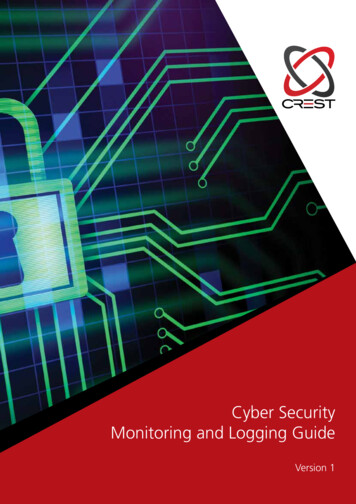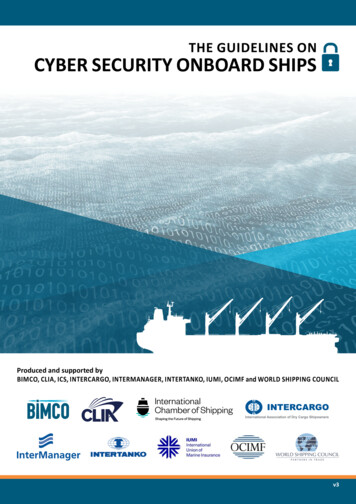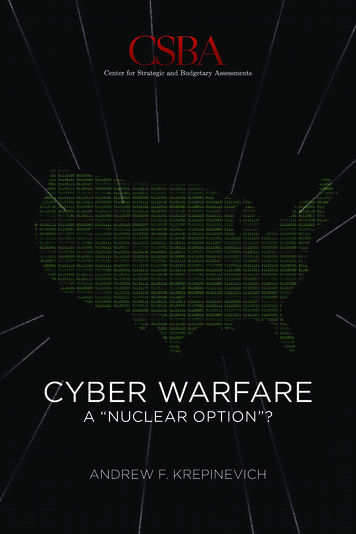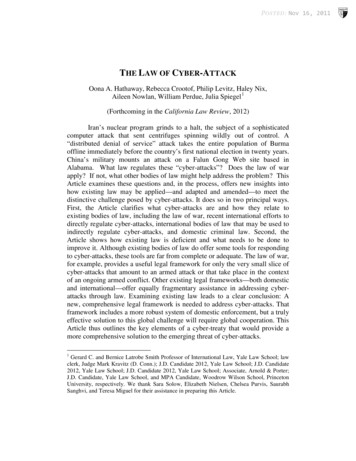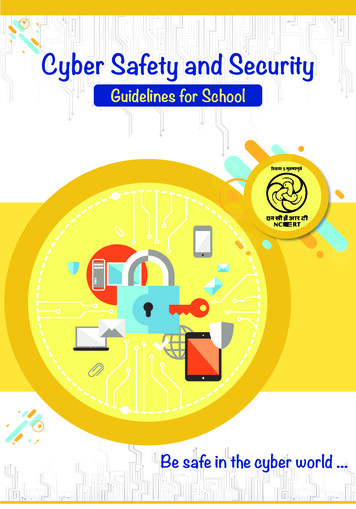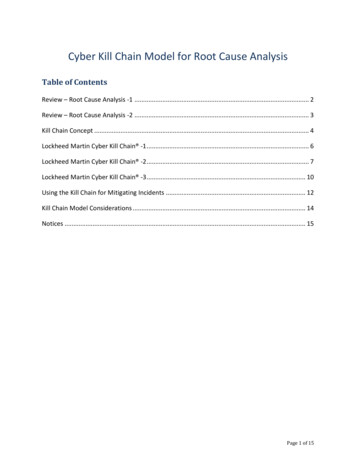
Transcription
Cyber Kill Chain Model for Root Cause AnalysisTable of ContentsReview – Root Cause Analysis -1 . 2Review – Root Cause Analysis -2 . 3Kill Chain Concept . 4Lockheed Martin Cyber Kill Chain -1 . 6Lockheed Martin Cyber Kill Chain -2 . 7Lockheed Martin Cyber Kill Chain -3 . 10Using the Kill Chain for Mitigating Incidents . 12Kill Chain Model Considerations . 14Notices . 15Page 1 of 15
Review – Root Cause Analysis -1Review – Root Cause Analysis -1Definitions A root cause is an initiating or highest level cause of a problem.(sources:- Wikipedia: https://en.wikipedia.org/wiki/Root cause- ASQ: ysis/overview/overview.html) Root cause analysis is the understanding of the "design" or"implementation" flaw that allowed the attack.(source: FIRST “Security Incident Response Team (SIRT) Services Framework,”https://www.first.org/ assets/global/FIRST SIRT Services Framework Version1.0.pdf)[Distribution Statement A] This material has been approved for public release and unlimiteddistribution.44**004 So first let's do a quick reviewof what root cause analysis is.Basically root cause is the underlyingor fundamental or initiating highestlevel cause of a particular problem orissue. In this case we're looking atcybersecurity incidents. So rootcause analysis is understanding whatthe flaw or the problem or issue isthat allowed that particular incidentor attack to occur.Page 2 of 15
Review – Root Cause Analysis -2Review – Root Cause Analysis -2Why do a root cause analysis? can benefit other incident management processes, such asprevention, detection, and responseWhen? usually during the detailed analysis steps of the incidentresponse process, but can also occur with other analysis stepsanywhere in the incident management lifecycleHow? using a list of causes or threat vectors and a methodicalapproach, and analyzing available information sources[Distribution Statement A] This material has been approved for public release and unlimiteddistribution.55**005 Why do we want to do rootcause analysis? Well, it's going tobenefit other types of incidentmanagement processes, andparticularly the response process, inproviding a more targeted, focusedresponse to that particular problemor issue. It can also help with theprevention and detection of incidentsfrom reoccurring on that samesystem or occurring on othersystems, if you understand what trulyallowed the incident to occur.It generally occurs during theanalysis phase of the incidentresponse processes, but it can alsohappen during the initial detection,Page 3 of 15
triage, or other analysis phase thathappened anywhere during theincident management lifecycle.And how it is performed by havingsome kind of understanding, a list ofcauses or threat vectors, having anapproach or a process for identifyingthose threat vectors, and havingavailable information to analyze fromvarious data sources that can beused in the root cause analysis.Kill Chain ConceptKill Chain ConceptKill chain is a term originally used to define a military concept of“target identification, force dispatch to target, decision and order toattack the target, and the destruction of the target”(source: r-Force-Jargon/Kill-Chain)In information security, “a kill chain is a systematic process totarget and engage an adversary to create desired effects.”(source: “Intelligence-Driven Computer Network Defense Informed by Analysis of Adversary Campaigns and Intrusion Kill -Intel-Driven-Defense.pdf)Identifying and understanding the phases (kill chain) of a cyberattack can enable better defense and response to an incident.[Distribution Statement A] This material has been approved for public release and unlimiteddistribution.66**006 So Lockheed Martin has takena concept called kill chain, which wasa term originally used in the military.It's a concept for identifying aPage 4 of 15
particular target, dispatching a forceto that particular target, deciding toattack the target, and then actingupon that target. So that's how "killchain" is used in a military context.So Lockheed Martin took this sameterm and applied it to informationsecurity, and in an informationsecurity context, a kill chain is thesystematic process to target andengage an adversary and create-and their ability to create the desiredeffects. So in the case of acybersecurity incident, we're trying todisrupt or deny the adversary or theattacker the ability to perform thatparticular incident, and byunderstanding the different phases ofthe kill chain that an attacker mightuse can then better identify wherewe can put in places to detect thatactivity, to mitigate, to preventagainst it, and to put other defensivecontrols or mitigation actions inplace.Page 5 of 15
Lockheed Martin Cyber Kill Chain -1Lockheed Martin Cyber Kill Chain -1Lockheed Martin (LM) expanded the kill chain concept to present acyber intrusion kill chain model with seven phases:1. Reconnaissance2. Weaponization3. Delivery4. Exploitation5. Installation6. Command and control (C2)7. Actions on objectives(source: “Intelligence-Driven Computer Network Defense Informed by Analysis of Adversary Campaigns and Intrusion Kill Intel-Driven-Defense.pdf)[Distribution Statement A] This material has been approved for public release and unlimiteddistribution.77**007 So looking at LockheedMartin's Kill Chain Model, Cyber KillChain Model, they took the conceptand they identified seven differentphases that attacker will typically gothrough. Not for every incident butfor many incidents, these are thephases.The first step is reconnaissance,where they're trying to identifyinformation. We'll describe these in alittle bit more detail in the next slideand show some examples. A secondphase might be weaponizing orcreating some way to actually attackthe system. Delivering that attackmechanism is the third phase-Page 6 of 15
exploiting perhaps a vulnerability thatmight exist, installing some additionalsoftware or some future access,taking control of the system, andthen performing what actions theyintend to on the system they've takencontrol of.Lockheed Martin Cyber Kill Chain -2Lockheed Martin Cyber Kill Chain -2The seven steps of the process provide visibility into an attack andan understanding of the adversary’s objectives.(source: l-chain.html)[Distribution Statement A] This material has been approved for public release and unlimiteddistribution.88**008 So in this table we showexamples of typical scenarios ortypes of incidents that might be alittle bit more descriptive of thedifferent phases or steps in anintruder's process.So under the reconnaissance phase,a typical example might be they'rePage 7 of 15
doing some probing or scanning orthey identify some weakness; in thiscase, they find a gap in the securityof a particular social network. Soidentifying that gap or that target isthe first phase.Phase two, the weaponization, in thiscase they might build or acquire ordownload or find another way toexploit that weakness by perhapsusing some malicious software, amalicious attachment, that they canthen upload or send to users of thatparticular social network.In the third phase, delivery, theattacker actually delivers thatparticular malicious attack on thesocial media, or perhaps an emailmessage or some other-- luring themto a website that might look likesomething the user-- in this case, anemployee of the organization-- mightbe able to use.And then the next phase,exploitation-- in this particularscenario, a user or an employeemight open the particular maliciousattachment and therefore cause avulnerability to be exposed. Theinstallation phase is where themalware does install itself on theclient system that the user hadaccess to.And then the sixth phase of the killchain is what they call the commandand-control, the C2 phase, where theattacker actually takes control of thatsystem through this particularmalicious software that had beenPage 8 of 15
downloaded. Perhaps it's set upsome backdoors, some unauthorizedaccounts, opened ports or serviceson particular systems, whatever theway that the malicious code isdesigned.And then the final phase, actions onthe objectives-- they can thentherefore-- in this scenario theattacker can identify other systems,other critical information, otherresources they might use on thiscontrolled system they've been ableto obtain access to, to perform followup actions.So this is just kind of a high-leveloverview of how the Lockheed MartinKill Chain concept is applied in theirroot cause analysis model.Page 9 of 15
Lockheed Martin Cyber Kill Chain -3Lockheed Martin Cyber Kill Chain -3Intrusion reconstruction Kill chain analysis can help analysts understand whatinformation is (or may be) available for defensive courses ofaction.- Late phase detection- Earlier phase detection(Source: “Intelligence-Driven Computer Network Defense Informed by Analysis of AdversaryCampaigns and Intrusion Kill ntel-Driven-Defense.pdf)[Distribution Statement A] This material has been approved for public release and unlimiteddistribution.99**009 So how can we use this forroot cause analysis? Well,understanding the different phases ofthe kill chain can then be used inidentifying the courses of action thatan incident responder may be able touse to try to put in defensivecontrols. In this slide we show twodifferent examples, and typically if anincident is not detected until laterphases of the process of the killchain, generally the detection, thethings that you'll have to analyze totrack back all the different possibleways that the incident may haveoccurred, there's going to be moreenumerated different possibilities anddifferent controls that might need toPage 10 of 15
be put in place to identify andmitigate and defend against thisparticular type of attack.However, ideally, Lockheed Martinproposes the goal is to try to movethe identification and detection toearlier phases in the kill chain, and ifyou can stop them from installing orexploiting the vulnerabilities then it'sgoing to be easier, more effective, tocontrol and put defensive measuresin place. And then also synthesizingthe information from the successfuldefenses that you put in place andthe unsuccessful attacks can thenfeed back into the other processes inprevention and detection of otherincidents.Page 11 of 15
Using the Kill Chain for Mitigating IncidentsUsing the Kill Chain for Mitigating IncidentsTable 1: Courses of Action Matrix(source: “Intelligence-Driven Computer Network Defense Informed by Analysis of AdversaryCampaigns and Intrusion Kill ntel-Driven-Defense.pdf)[Distribution Statement A] This material has been approved for public release and unlimiteddistribution.1010**010 So here's another example oflooking at mapping the seven phasesof the Lockheed Martin Kill Chain tosix categories that the United StatesDepartment of Defense identify aspart of their Information OperationsDoctrine, and these informationoperations characteristics are detect,deny, disrupt, degrade, deceive ordestroy. So they've mapped theseDoD information operations to thevarious phases of the kill chain, theintruder's kill chain, and show howyou might be able to implementdifferent controls or methods toprevent an incident from happening.Page 12 of 15
So for example, in the previousscenario where we had exploitation,if you have host-based intrusiondetection systems you might be ableto quickly detect and perhaps preventthe attempted exploitation of thismalicious code from being installed.If you have particular securitypatches installed in place to preventthat vulnerability from beingexploited, this can deny theexploitation action from occurring.And if it gets past these two layers ofdefense, you might be able to disruptthe execution of that exploitation byhaving things such as data executionprevention tools or methods in placeon that particular system.So this just shows an exampleof various types of defense-in-depthmethods, approaches, techniques toidentify and map, and knowing,understanding the differentrelationships between these can alsohelp us focus on identifying, if wecan, the underlying root causes andhow we can map that to theresponse course of actions.Page 13 of 15
Kill Chain Model ConsiderationsKill Chain Model ConsiderationsThe LM Cyber Kill Chain model’s threat vectors are malware- and[external] intrusion-focused. How do you apply it to insider threats? How do you apply it to attacks that did not exploit vulnerabilitiesor install malware (e.g., social engineering)?Typically little is discoverable about the attacker’s activities inphases 1 and 2 (reconnaissance and weaponization) of the cyberkill chain, and such knowledge is not as “actionable” as theinformation identified in the later phases.[Distribution Statement A] This material has been approved for public release and unlimiteddistribution.1111**011 Now, some of the things tokeep in mind is that this kill chainmodel is focused primarily onintrusions and malware-focused,external types of incidents andattacks, and so it might apply tothose better than, say, for example, ifyou had an insider incident, whereyou don't have malware being usedor you don't have an unauthorizedintrusion. And what happens if youhave an incident that does not usesocial engineering-- or not exploitingvulnerabilities or installing malware,that it is taking advantage ofimpersonation or deceiving theusers? This model is not quite asapplicable as other types of approaches.Page 14 of 15
Another thing to keep in mind is thatthe earlier phases, as far as thereconnaissance and weaponizationthat occurs, often there's not a lot ofdiscoverable information in thosetypes of phases that can beactionable, so you'll have to focus onthe later phases of the kill chainfor actionable courses of your response.NoticesNoticesCopyright 2016 Carnegie Mellon University[Distribution Statement A] This material has been approved for public release and unlimited distribution. Please see Copyright notice for non-USGovernment use and distribution.This material is based upon work funded and supported by Department of Homeland Security under Contract No. FA8721-05-C-0003 with CarnegieMellon University for the operation of the Software Engineering Institute, a federally funded research and development center sponsored by theUnited States Department of Defense.NO WARRANTY. THIS CARNEGIE MELLON UNIVERSITY AND SOFTWARE ENGINEERING INSTITUTE MATERIAL IS FURNISHED ON AN“AS-IS” BASIS. CARNEGIE MELLON UNIVERSITY MAKES NO WARRANTIES OF ANY KIND, EITHER EXPRESSED OR IMPLIED, AS TO ANYMATTER INCLUDING, BUT NOT LIMITED TO, WARRANTY OF FITNESS FOR PURPOSE OR MERCHANTABILITY, EXCLUSIVITY, ORRESULTS OBTAINED FROM USE OF THE MATERIAL. CARNEGIE MELLON UNIVERSITY DOES NOT MAKE ANY WARRANTY OF ANY KINDWITH RESPECT TO FREEDOM FROM PATENT, TRADEMARK, OR COPYRIGHT INFRINGEMENT.This material is distributed by the Software Engineering Institute (SEI) only to course attendees for their own individual study. Except for the U.S.government purposes described below, this material SHALL NOT be reproduced or used in any other manner without requesting formal permissionfrom the Software Engineering Institute at permission@sei.cmu.edu.The U.S. Government's rights to use, modify, reproduce, release, perform, display, or disclose this material are restricted by the Rights in TechnicalData-Noncommercial Items clauses (DFAR 252-227.7013 and DFAR 252-227.7013 Alternate I) contained in the above identified contract. Anyreproduction of this material or portions thereof marked with this legend must also reproduce the disclaimers contained on this slide.Although the rights granted by contract do not require course attendance to use this material for U.S. Government purposes, the SEI recommendsattendance to ensure proper understanding.Carnegie Mellon , CERT and CERT Coordination Center are registered marks of Carnegie Mellon University.DM-0003588[Distribution Statement A] This material has been approved for public release and unlimiteddistribution.2Page 15 of 15
Review – Root Cause Analysis -2 Why do a root cause analysis? can benefit other incident management processes, such as prevention, detection, and response When? usually during the detailed analysis steps of the incident response process, but can also occur with other analysis







